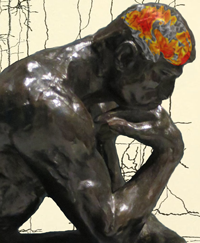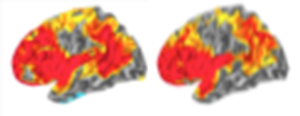Archived Content
The National Institute of Mental Health archives materials that are over 4 years old and no longer being updated. The content on this page is provided for historical reference purposes only and may not reflect current knowledge or information.
Secrets to Our Smarts Hidden in the Folds of Our Cortex
• Science Update
The more folding in the thinking parts of our brain, the smarter we are – to a degree. That’s the take-home of by far the largest study of its kind into the connection between such brain gyrification and human intelligence.

Increasing gyrification in a network of regions in the human brain’s outer mantle is significantly associated with general cognitive ability, a finding replicated in 440 healthy adults and in an independent sample of 662 healthy children who underwent structural MRI scans and extensive neuropsychological testing. The cortex maps showing networks in which gyrification correlates with intelligence are remarkably similar across the two groups. The relationship was also consistent across sexes, the age span, and different methods of estimating intelligence.
“The areas in which intelligence correlated with folding share in common the ability to process information from multiple sensory modalities,” explained Gregory. “These results are consistent with evidence across species and fit well into an evolutionary context.”
The findings support the theory that intelligence hinges on interactions between the brain’s parietal and frontal lobes. These cortex areas are comprised of six cellular layers that underwent rapid expansion through human evolution. Folding presumably enabled burgeoning circuitry to fit within the confines of the skull.
The results add to evidence that regions of the brain that each take in information from just one sense, which are comprised of fewer layers, feed it to the parietal lobe for abstraction and elaboration. Interactions between the highly-folded tissues of the parietal and frontal lobes test hypotheses about the information and make decisions, which are then translated into responses by the cingulate cortex. Added to evidence from comparative biology, the findings suggest that folding in these particular brain regions shows a stronger connection to intelligence than overall brain size.
However, the connection to folding accounted for only 6-12 percent of variation in general intelligence, leaving much of such variance attributable to a variety of other factors, including environment. Still, the researchers say their MRI maps hold potential insights into the cellular architecture of specialization in the human brain.

Composite MRI data showing brain areas correlated with intelligence were remarkably similar in large independent samples of adults (left) and children (right). Red indicates a stronger connection.
Reference
Gregory MD, Kippenham JS, Dickinson D, Carrasco J, Mattay VS, Weinberger DR, Berman KF. Regional variations in brain gyrification are associated with general cognitive ability in humans. Current Biology, April 28, 2016.
